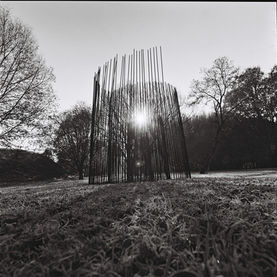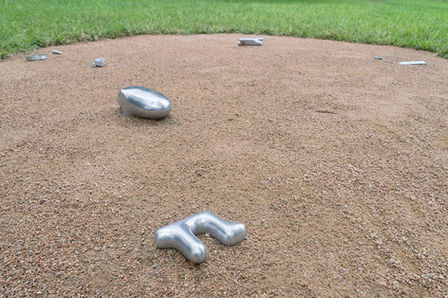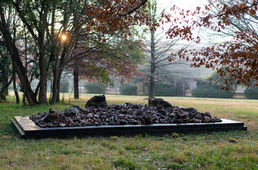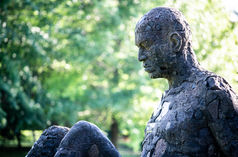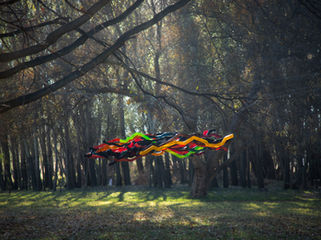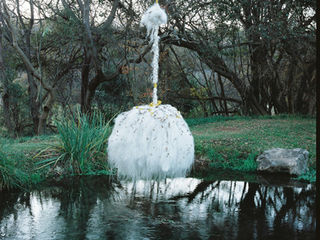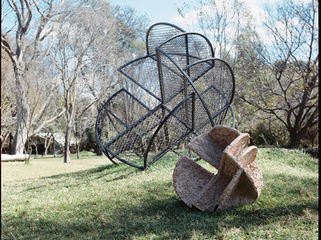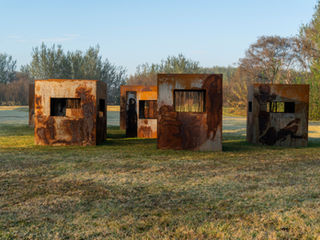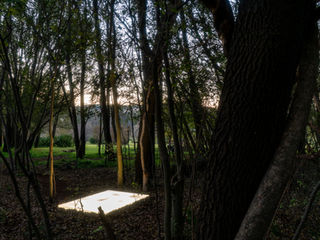NIROX Sculpture Park is 30ha of cultivated lawns, arbors, fields, waterways, and wetlands, on the banks of the Blaauwbankspruit River adjoining the Kkatlhamphi Private Nature Reserve — a 1000ha wilderness of hills, valleys, riverine forests, caves, and highveld grasslands, populated with diverse local game and birdlife.
The Park hosts more than 50 permanent and long-term installations by artists from across the globe; and at least one annual large scale curated exhibition of new and temporary installations and performances, in collaboration with NIROX’ wide circle of global partners and curatorial affiliations.
NEW ADDITION
PAULA ANTA
Plasticised Trees, 2025
During her residency, Paula created 'Plasticised Trees' in response to the overwhelming presence of plastic in our environment. Made largely from fossil fuels, plastic drives climate change and contaminates ecosystems, from the peaks of Everest to human breast milk.
Paula wraps fallen trees in discarded plastic bags, then heat bonds the material to the bark, forming a second skin that is both protective and confronting.
Referencing waste-sorting colour codes in Europe and the corporate branding saturating South Africa, the works stand as evidence, not debris—imagining how the remains of environmental damage might form part of its repair.
EXTERIOR II, 2023
Wood
156 x 94 x 62 cm
Exterior II (2023) was installed shortly after the opening of Serge Alain Nitegeka's exhibition Structural Response IV (2023–24) in NIROX's Covered Space. The artwork was produced while in residence, in the Villa-Legodi Centre for Sculpture's Workshop. Exposed to the elements, it will eventually begin to shows signs of weathering. To learn more about Nitegeka's practice, click on the button below.
SERGE ALAIN NITEGEKA
The Structure of Things to Come: The Favour of Survival. 2025
DIEGO MASERA
HOME - ikhaya, 2025
HOME – ikhaya reflects on the precarious reality of millions who inhabit informal settlements—structures born of necessity, crafted from whatever materials can be found. These makeshift architectures speak to an existence shaped by impermanence and systemic socio-economic disparities.
This work seeks to confront that reality while acknowledging the profound beauty, resilience, and dignity embedded within it. The use of gold leaf evokes Johannesburg’s origins as a city founded on wealth extracted from the earth, contrasting sharply with the enduring poverty surrounding it. In doing so, the sculpture becomes a dialogue between abundance and deprivation, permanence and transience.
The title itself underscores a deeper inquiry: the distinction between a house—a physical shelter—and a home, an intimate, often fragile, construct of belonging and connection. Through HOME – ikhaya, I invite viewers to reflect on what constitutes home, to reconsider our interdependence as human beings, and to reimagine community as a shared space with one another and with nature.
RECENT ADDITIONS
EXTERIOR II, 2023
Wood
156 x 94 x 62 cm
Exterior II (2023) was installed shortly after the opening of Serge Alain Nitegeka's exhibition Structural Response IV (2023–24) in NIROX's Covered Space. The artwork was produced while in residence, in the Villa-Legodi Centre for Sculpture's Workshop. Exposed to the elements, it will eventually begin to shows signs of weathering. To learn more about Nitegeka's practice, click on the button below.
SERGE ALAIN NITEGEKA
THE STRUCTURE OF THINGS TO COME: THE FAVOUR OF SURVIVAL
MATTHEW JAMES LANNING, 2025
Situated at the heart of the park is a work by Matthew James Lanning, “The structure of things to come: The favour of survival. 2025” produced during his time in residency at NIROX. Lanning was in residence some weeks ago, developing a body of work rooted in his research on urban space and its often-overlooked formal language.
His practice examined the standardised modules that construct the urban environment, shapes and fragments so familiar they typically go unnoticed. During his time here, he rematerialised these forms, blurring the line between the artificial and the natural. Through this process, he offered new ways of thinking about collectivity, habitation, and what it means to be human in a moment when the very definition of humanity feels increasingly uncertain.
Each fold, variation, and sculptural intervention became a proposition, challenging conventional ideas of standardisation and its assumed aesthetic or functional logic. His work asked us to reconsider not only the environmental impact of domestic aesthetics, but also the complex social meanings embedded within them.

EXTERIOR II, 2023
Wood
156 x 94 x 62 cm
Exterior II (2023) was installed shortly after the opening of Serge Alain Nitegeka's exhibition Structural Response IV (2023–24) in NIROX's Covered Space. The artwork was produced while in residence, in the Villa-Legodi Centre for Sculpture's Workshop. Exposed to the elements, it will eventually begin to shows signs of weathering. To learn more about Nitegeka's practice, click on the button below.
SERGE ALAIN NITEGEKA
CAMP
SERGE ALAIN NITEGEKA, 2025
Refugee camps of the late twentieth-century Central Africa, with their tents and makeshift structures, attest to the itinerant experiences of displaced peoples. A camp represents a temporary shelter, where individuals are in transit, on their way somewhere else.
Nitegeka’s interest stems from the dynamics of fleeing, managing possessions, and survival. It speaks to the in-between space one navigates, from the homes they leave behind to the new and unfamiliar ones they encounter.
Camp is an ongoing, accumulative series comprised of a number of sculptures resembling tents, set out in an open field. Made from white canvas and PVC conduit tubing, the sculptures are stitched solid. At night, a warm yellow-orange light radiates from within, visible to passersby, often those coming to and from work. The glow implies occupation or presence: people going about their evening routines before going to bed; a marker of life, resilience, and hope.

EXTERIOR II, 2023
Wood
156 x 94 x 62 cm
Exterior II (2023) was installed shortly after the opening of Serge Alain Nitegeka's exhibition Structural Response IV (2023–24) in NIROX's Covered Space. The artwork was produced while in residence, in the Villa-Legodi Centre for Sculpture's Workshop. Exposed to the elements, it will eventually begin to shows signs of weathering. To learn more about Nitegeka's practice, click on the button below.
SERGE ALAIN NITEGEKA
PARENTHESIS
KHALID ALBIAH, 2025
Supported by Qatar Museums, Parenthesis is a facade of a life-size bronze sculpture portraying a fallen dictatorship on top of a plinth.
Viewers can climb the plinth and settle their bodies behind the sculpture, filling in the shape, symbolising the transformative journey from individual to dictator. However, as participants reach the zenith, they are compelled downwards, mirroring the inescapable downfall of dictators.
The sculpture serves as a metaphor for the cyclical nature of power and the shared destiny of those seduced by autocratic tendencies.

EXTERIOR II, 2023
Wood
156 x 94 x 62 cm
Exterior II (2023) was installed shortly after the opening of Serge Alain Nitegeka's exhibition Structural Response IV (2023–24) in NIROX's Covered Space. The artwork was produced while in residence, in the Villa-Legodi Centre for Sculpture's Workshop. Exposed to the elements, it will eventually begin to shows signs of weathering. To learn more about Nitegeka's practice, click on the button below.
SERGE ALAIN NITEGEKA
FUTURE. FABLES
VIBHA GALHOTRA, 2024
Constructed from reclaimed rubble and steel, this architectonic sculpture explores themes of resilience, ecology, and shared histories. Driven by the ongoing interaction between humans and their environment, Vibha’s practice combines rigorous research with intuitive creativity to examine the social, economic, and political consequences of human actions on the planet.
Drawing from diverse fields such as fine arts, ecology, economics, science, spirituality, and political activism, her work offers a poetic visual reflection on environmental shifts and the cultural, societal, and geographic transformations shaping the world today. Set along the serene banks of the Blaauwbankspruit River, adjacent to the Kkatlhamphi Private Nature Reserve, Future Fables invites visitors to reflect on its compelling narrative within a tranquil natural setting.


EXTERIOR II, 2023
Wood
156 x 94 x 62 cm
Exterior II (2023) was installed shortly after the opening of Serge Alain Nitegeka's exhibition Structural Response IV (2023–24) in NIROX's Covered Space. The artwork was produced while in residence, in the Villa-Legodi Centre for Sculpture's Workshop. Exposed to the elements, it will eventually begin to shows signs of weathering. To learn more about Nitegeka's practice, click on the button below.
SERGE ALAIN NITEGEKA

JOHAN THOM, 2024
Dwell is a large replica of a red building brick, such is commonly used for the construction of homes, shelters, and buildings in South Africa. In the exhibition it functions as a conceptual and formal foil to Will You still be mine#1 (Del Mar). Also made to the weight of the artist, it is a deceptively complex minimalist gesture in which the body is shown to be a contested, uneasy home — at once a space of ‘dwelling’ (of knowing and being) whilst also forming part of the skewed spatio-political and economic organisation of the contemporary South African landscape.
The surface of the sculpture is finished in the Yakisugi style, the traditional Japanese system practiced over many millennia of slightly charring the surface of the wood without combusting the whole piece to prevent insect attack, rot and weathering.
In its final form Dwell exists in two forms: An edition of 6 clay bricks produced with the assistance of Map South Africa (Richmond) and as a large-scale photograph showing the permanent installation of the brick in the landscape of the Cradle of Humankind at the Nirox Sculpture Park upon the completion of the exhibition (as shown here).
DWELL

EXTERIOR II, 2023
Wood
156 x 94 x 62 cm
Exterior II (2023) was installed shortly after the opening of Serge Alain Nitegeka's exhibition Structural Response IV (2023–24) in NIROX's Covered Space. The artwork was produced while in residence, in the Villa-Legodi Centre for Sculpture's Workshop. Exposed to the elements, it will eventually begin to shows signs of weathering. To learn more about Nitegeka's practice, click on the button below.
SERGE ALAIN NITEGEKA

JONATHAN FREEMANTLE, 2024
A totem (from Ojibwe: ᑑᑌᒼ or ᑑᑌᒻ doodem) is a spirit being, sacred object, or symbol that serves as an emblem of a group of people, such as a family, clan, lineage, or tribe. Carved from a single poplar tree that was felled at Nirox, this totem evokes the ancient concept of the ‘Eternal Flame’. I intended for this sculpture to resemble a figure twisting and reaching upwards; an antannae of sorts, simultaneously ready to transmit and receive. I see this totem as an embodiment of the lightening that strikes the hills of the Cradle of Humankind all summer long.
The surface of the sculpture is finished in the Yakisugi style, the traditional Japanese system practiced over many millennia of slightly charring the surface of the wood without combusting the whole piece to prevent insect attack, rot and weathering.
FIRE TOTEM - FOREVER BURNING

SERGIY PETLYUK, 2024
The notion of ‘home’, Sergiy goes on to say, is profoundly important in shaping an individual’s worldview, particularly during formative years. It serves as a bastion of security, grounding one’s sense of identity within the family and wider society. The loss of home, whether tangible or metaphorical, catalyses irreversible changes in one’s life trajectory. This project is a tribute to those who grapple with the upheaval of losing their home and the struggle to regain it. It’s also a poignant tribute to the countless Ukrainian children who were kidnapped and torn from their homes and country in the turmoil of the Ukrainian-Russian war, as well as those innocents in other parts of the world — Gaza, Sudan, the Democratic Republic of Congo, amongst others — whose lives have been upended by war.
IN SEARCH OF A LOST HOME
LONG-TERM

PAST







